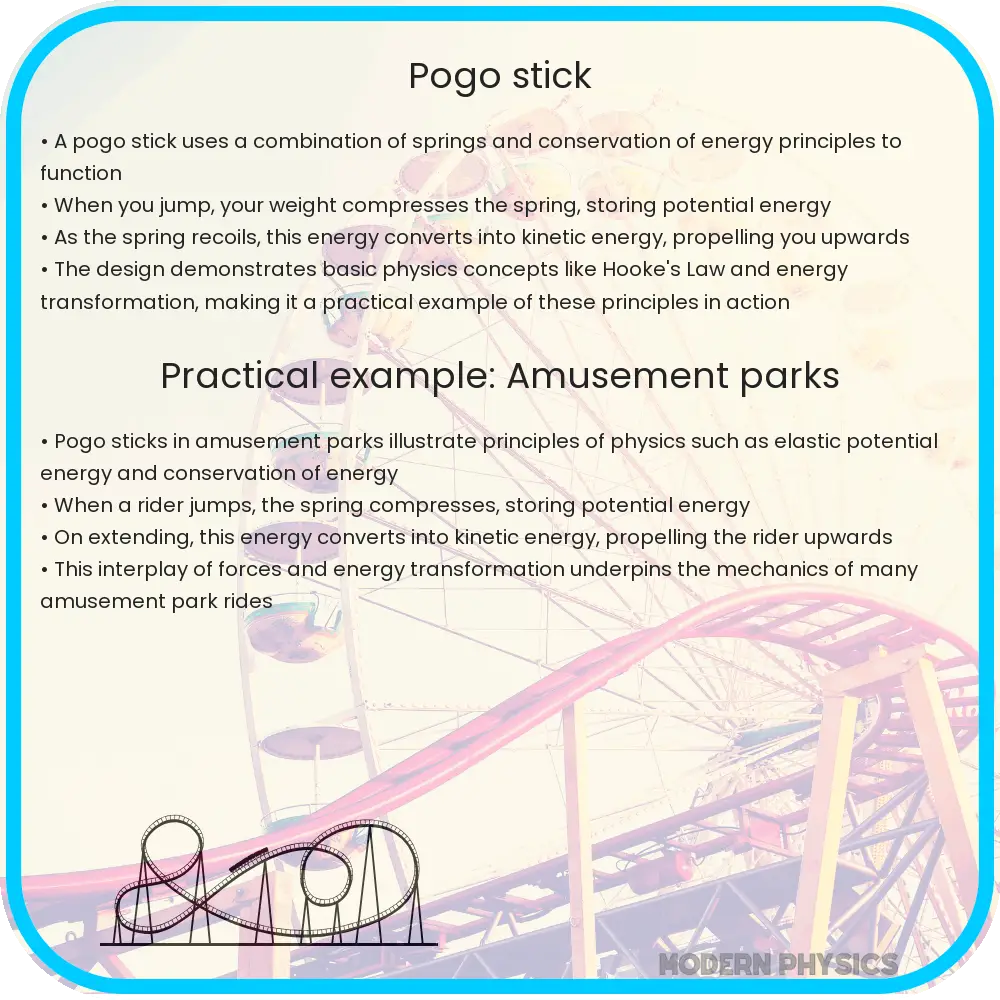Explore the mechanics of pogo sticks, delving into thrust, energy transformations, and motion dynamics, with safety and design optimization insights.

Understanding Pogo Stick Mechanics: Thrust, Energy, and Motion Dynamics
The pogo stick, a popular toy and sports equipment, is a fascinating example of mechanical engineering. To understand its working principles, it’s crucial to explore the concepts of thrust, energy, and motion dynamics. These elements combine to turn a simple bounce into an exhilarating leap.
Thrust Generation in Pogo Sticks
Thrust in pogo sticks is primarily generated through a spring mechanism. When a rider jumps onto the pogo stick, their weight compresses the spring, storing potential energy. As the spring decompresses, this energy converts into kinetic energy, propelling the rider upward. The thrust force can be calculated using Hooke’s Law:
F = -kx
Where F is the force exerted by the spring, k is the spring constant, and x is the displacement of the spring from its equilibrium position.
Energy Transformations
Energy transformation is a key aspect of pogo stick mechanics. The process starts with gravitational potential energy when the rider is at the peak of a jump. As the rider descends, this potential energy converts into kinetic energy. Upon landing, the kinetic energy transforms back into potential energy as the spring compresses. This cycle of energy transformation is continuous during pogo stick use, demonstrating the conservation of energy principle:
PEtop = KEbottom
PE stands for potential energy, and KE for kinetic energy.
Motion Dynamics
The dynamics of motion in pogo stick use involve both linear and angular movements. As the rider bounces, there is a linear vertical motion dictated by Newton’s Second Law of Motion:
F = ma
Here, F is the net force (including gravity and spring force), m is the mass of the rider and pogo stick, and a is the acceleration. Angular motion comes into play as the rider adjusts their body to maintain balance and control the direction of the bounce.
In conclusion, understanding the mechanics of a pogo stick involves an intricate interplay of physics concepts. The next section will delve deeper into the practical applications of these principles, including safety considerations and performance optimization in pogo stick design.
Practical Applications and Optimization in Pogo Stick Design
The principles of thrust, energy, and motion dynamics are not just theoretical concepts; they play a crucial role in the practical design and use of pogo sticks. By understanding and applying these principles, manufacturers can optimize pogo stick performance and safety.
Safety Considerations
Safety is paramount in pogo stick design. A key aspect is the spring mechanism, which must be strong enough to withstand repeated compressions and expansions without failure. The choice of material for the spring, such as high-grade steel, is crucial to ensure durability and consistent performance. Additionally, the design of the footpads and handlebars directly impacts the rider’s control and balance, reducing the risk of falls.
Performance Optimization
To enhance the performance of pogo sticks, designers focus on optimizing the spring constant and the overall weight of the device. A higher spring constant results in greater thrust, allowing for higher jumps. However, this needs to be balanced with the rider’s weight and skill level. Reducing the weight of the pogo stick through the use of lightweight materials like aluminum or carbon fiber can also improve maneuverability and ease of use.
Advanced Technologies
Recent advancements in materials science and engineering have led to the development of pogo sticks that use air or hydraulic systems instead of traditional springs. These systems offer more precise control over the compression and rebound dynamics, enabling higher and smoother jumps. Moreover, they often come with adjustable settings, making the pogo stick adaptable to different user preferences and skill levels.
Conclusion
The pogo stick, a seemingly simple device, encapsulates a complex interplay of mechanical principles. Understanding the mechanics of thrust, energy, and motion dynamics not only enhances our appreciation of this device but also guides manufacturers in improving its safety and performance. As technology advances, the evolution of pogo sticks continues, pushing the boundaries of what these devices can achieve. Whether used for recreation or as a competitive sport, the pogo stick remains a fascinating example of applied physics in motion.
In summary, the pogo stick is more than just a toy; it’s a testament to human ingenuity and the practical application of physics in our everyday lives. Its continued evolution and popularity underscore the joy and excitement found in the simple act of bouncing, powered by the fundamental laws of physics.
